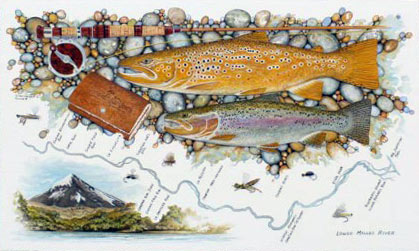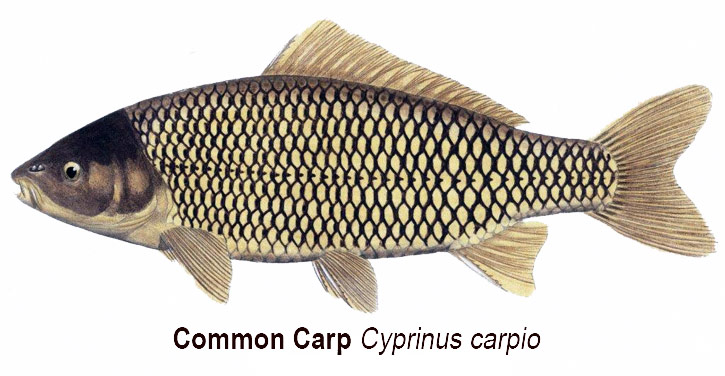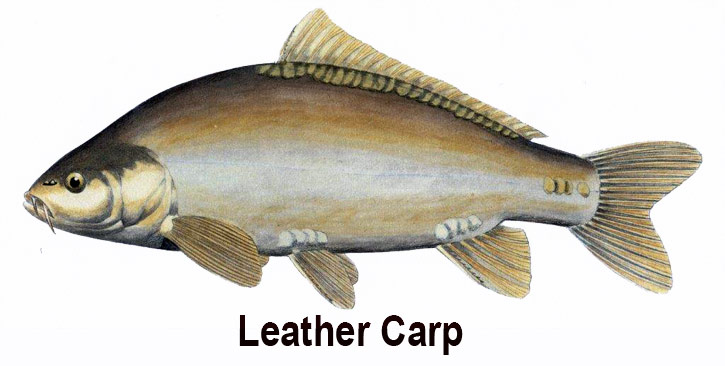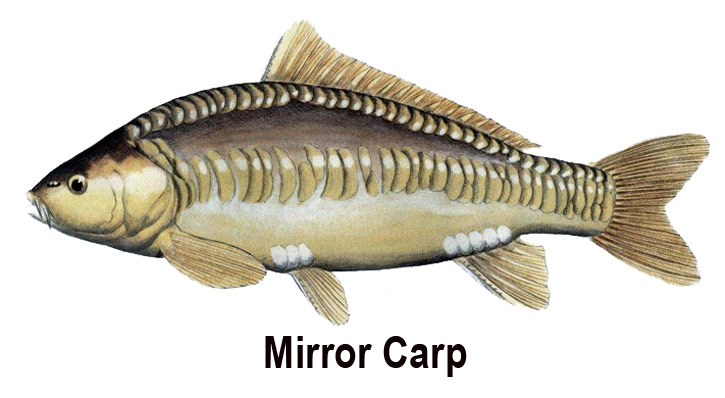Common Carp, September 2013, Fish of the Month!
A Brief Note to Our Readers:
Arranged in taxonomic (scientific) order, this column has, with this entry, passed out of the realm of our fly rod glamour species, the Trouts and Salmons (and even the Pikes), and into a broader realm of generally warm water-loving species. To this end, we’ll jump into these habitats and species with both feet and begin with the Minnows.
“Minnows?!?” we can hear you exclaiming. Yes, minnows. “You mean there are 30 pound minnows?!?” Yup, there are and we’re going to lead into all this with two of them.
Common Carp
Cyprinus carpio
Local Names:
Carp, Asian carp, German carp, Wild carp, European carp
Average Size:
24 to 36 inches
8 to 20 pounds
and occasionally much larger
Distinguishing Field Marks:
Color and color pattern are reliable distinguishing field marks for this species. (See the illustration.)
-
A deep bodied, broad backed fish.
-
The body shows distinct rows of large darkly outlined scales, but the head has no scales.
-
The mouth is sub-terminal (below the end of the upper jaw) and is protrusible- when extended it forms a suction tube. There is a long and a shorter barbell on each side of the upper jaw.
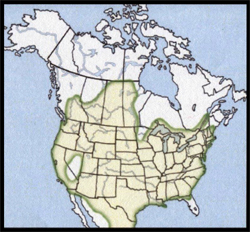
-
A single soft-rayed, very long dorsal fin extends along the back.
-
The tail fin is long, broad, deeply forked, and has rounded lobes.
The leading edges of the dorsal, anal, and pelvic fins are supported by serrated spines.
-
There are two additional naturally occurring forms of the Common carp, the Leather carp, and the Mirror carp (see illustrations). These are mutations of the typical Common carp scale structure and are not separate species or sub-species.
North American Range:
Map to the right shows approximate range in North America.
Biology:
Common carp spawn from early to mid-summer and sometimes into the fall as well. At spawning time, when the water temperature is about 62 degrees F., large groups of mature Common carp gather and begin swimming over shallow heavily vegetated in-shore areas. These groups of fish are very active and do plenty of noisy splashing at the water's surface, swimming rapidly about and frequently rolling and thrashing. They soon form smaller groups of 1 to 3 females and 3 to 15 males. Amid continued intense surface activity, the eggs and sperm are simultaneously broadcast and sink into the vegetation where they incubate. This spawning ritual may continue for several days, usually in the morning. Common carp are a very prolific species with each mature female carrying 30,000 to 2,000,000 eggs.
Common carp spawn from early to mid-summer and sometimes into the fall as well. At spawning time, when the water temperature is about 62 degrees F., large groups of mature Common carp gather and begin swimming over shallow heavily vegetated in-shore areas. These groups of fish are very active and do plenty of noisy splashing at the water's surface, swimming rapidly about and frequently rolling and thrashing. They soon form smaller groups of 1 to 3 females and 3 to 15 males. Amid continued intense surface activity, the eggs and sperm are simultaneously broadcast and sink into the vegetation where they incubate. This spawning ritual may continue for several days, usually in the morning. Common carp are a very prolific species with each mature female carrying 30,000 to 2,000,000 eggs.
Diet:
With their sucking protrusible mouths extended downward, Common carp browse the soft bottoms of their preferred habitats, rejecting dissolving mud and detritus through their gill rakers, and retaining any edible material. Several inches back in the throat of a Common carp are a set of strong molar-like teeth which encircle the digestive opening. These teeth are used to crush plant and animal foods, and demand a word of caution to anglers who often grasp hooked carp by putting a thumb into their mouths and a hand grip at the base of their tails; the teeth in a Common carp's throat can crush and break a human thumb or finger, so don't finger explore too deeply inside a carp's mouth.
Common carp are omnivorous, feeding on bottom-dwelling plant and animal food of whatever type they encounter, as well as feeding at or near the surface on plant matter, such as small fruits and seeds that fall from shoreline bushes or trees. They will also take small fish near or below the water's surface.
Fly Fishing for Common Carp:
It's almost safe to say that Common carp can be found anywhere its preferred habitat occurs in North America. Those habitats have ample shallow areas with soft bottom, are well vegetated, and are capable of warming into the 70 degree F. range during the summer months.
A fairly new aspect of carp fishing has begun to develop in the ranks of devoted fly fishers. The Common carp is often referred to as the "Freshwater Bonefish." A range of sinking nymph imitations and other more fanciful concoctions are now being fly cast to carp, usually after several have been spotted tailing or rolling in shallow water. This is commonly done while stealthily wading along productive-looking shoreline stretches. Truly large waters, such as the Great Lakes are best explored from a boat, and then waded once fish are found.
On any carp fishing outing, you'll want to leave your 4 wt. equipment behind and opt for minimum of 7 up to 9 weight outfits. Common carp tend to take a fly very softly, so rods with powerful butt sections and softer strike-sensitive tips are best. Balance these rods with reels capable of holding at least 150 yards of backing and designed with smooth powerful drags. Single action or anti-reverse up-take systems are left to your choice. Bass, Steelhead, Salmon, Striped bass? all rod/reel/line systems for these species will work equally well for carp. You'll want long virtually invisible leaders for presenting your fly to these fish.
In lakes or ponds, observing the water to be fished from a bit of elevation is a good approach. When cruising carp are spotted, wading and casting can begin. Because Common carp are very wary and will bolt at any unusual disturbance near them, you must approach these fish with extreme caution. When you see a fish (or several) tailing or cruising, choose one as your prime target and "lead" that fish when you make your cast, so that you fly lands and is sinking to bottom when the fish is still a good distance away, say, about 10 feet. Still water fly-rod carp angling is every bit as challenging as is sight-fishing for the revered salt-water Bonefish.
In moving water, locate fish and cast upstream from them, again allowing your fly to sink as it rolls along the bottom to the fish. This style of carp fishing is nearly identical to bottom nymph fishing for trout.
Although they do not jump when hooked, they certainly do in the course of their daily lives. Common carp are very strong powerful fish and will give any fly-fisher plenty of action. Their runs are fast and direct and nearly impossible to stop. Patience and finesse are requirements for both hooking and landing Common carp.
Significance to Humans:
Common carp are frequently thought to be native to East Asia, but, in truth, they are native only to central Asia, specifically the Caspian and Aral Sea basins. From there they were introduced further east. Later they were brought to Austria and Germany, then throughout Europe and to the British Isles.
In the 1870s, Spencer Baird, a former director of the Smithsonian Institution, and then recently appointed as the first Commissioner of the newly established U.S. Fish and Wildlife Service, was confronted with restoring the already rapidly declining populations of U.S. fresh and saltwater food and game fishes. He took his assignment very seriously and, having studied the Common carp of Europe, thought it might be an excellent addition to the U.S. freshwater fish community, especially as a food fish. So Mr. Baird imported some carp from Germany and stocked them into waters close to the Washington Monument. Then he then went to Congress and urged as many members of both houses as he could to come and see this "wonder fish." Many did, and many were told of the rapid growth and large size of this prolific spawner, and of its excellent reputation as a food fish in Europe, Asia, and Britain. Enough politicians were convinced that the first 3 or 4 years of work for the fledgling U.S. Fish & Wildlife Service was largely devoted to raising Common carp that were subsequently stocked out to the ponds of anyone agreeing with Mr. Baird's premise that carp could be a real blessing. However, North Americans were already catching and eating trout, salmon, Walleye, perch, bass, shad, pike, and other fresh water fish that they found quite to their liking. Carp, the "old country" import, was not as highly regarded as the less abundant native species. As a result, many carp ponds were simply abandoned or breached or flooded and their occupants freed to go forth and multiply, which they did and still do. Today, except in "old world" markets in major cities where "a nice carp" is still considered a delicacy, very few Common carp find their way to North American dinner tables. An internet search into classic carp fishing waters is sure to open many North American anglers' eyes. In Asia, Europe, and the British Isles, Common carp remain a highly regarded (revered?) food and game fish. To fish for them in hallowed carp waters, an angler must add his or her name to a long waiting list and pay a considerable sum for the privilege of simply being on the water (This explains the almost universal carp anglers' use of alarms on rod holders. Why? Because when your number is called, you're going to plan to sleep by your set of rods. Of course, this isn't the fly-rodders' approach). So, for those of us advocates of the long (fly) rod, here in North America, the ubiquitous Common carp offers a seemingly endless supply of close-to-home big fish freshwater fly-fishing opportunities to present our flies to carp so wild and un-educated that our visiting European, British, and Asian carp anglers tend to think, on experiencing our carp "trash" fishery, that they've just "died and gone to heaven."
Status:
Thriving and increasing its range, entirely through natural reproduction.




